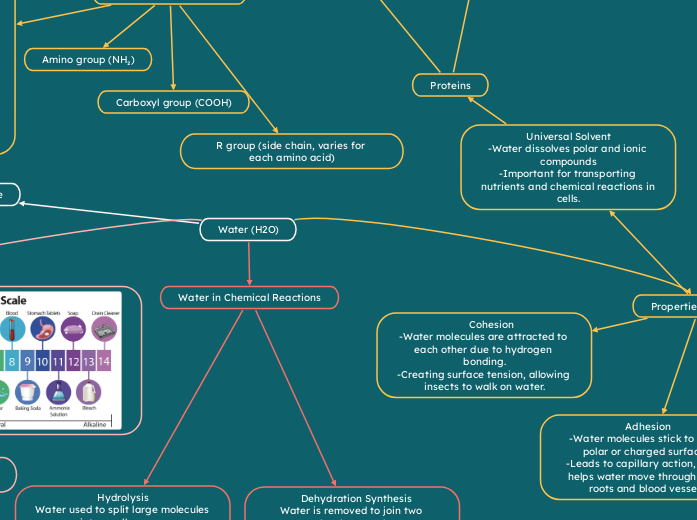von Wafiya Wasim vor 23 Tagen
33
Water (H2O)
Carbohydrates play a crucial role in providing energy, storing it, and offering structural support. They can be categorized into monosaccharides, disaccharides, and polysaccharides.

von Wafiya Wasim vor 23 Tagen
33

Mehr dazu
- Primary Energy Source - Energy Storage - Structural Support
Polysaccharides (Complex Carbohydrates)
Structural Polysaccharides
- Cellulose (plant cell walls, indigestible to humans) - Chitin (fungal cell walls, exoskeletons)
Storage Polysaccharides
- Starch (plants) → Stores glucose for energy - Glycogen (animals) → Stored in liver & muscles
Disaccharides (Two Monosaccharides Linked)
- Ex. Sucrose, Lactose, Maltose - Formed by dehydration synthesis - Broken down by hydrolysis
Monosaccharides (Simple Sugars)
- Ex. Glucose, Fructose, Galactose - Function: Quick energy source
Function
ATP: Provides energy for cellular activities
RNA: Helps build proteins
w
Nucleotides
- Sugar (Deoxyribose in DNA, Ribose in RNA) - Phosphate group - Nitrogenous base (A, T/U, G, C)
ATP (Adenosine Triphosphate)
- Energy carrier in cells - High-energy phosphate bonds
RNA (Ribonucleic Acid)
- Helps in protein synthesis - Single-stranded - Bases: A-U, G-C
Types:
tRNA → Brings amino acids to ribosomes
rRNA → Forms part of ribosomes
mRNA→ Carries genetic code from DNA to ribosomes
DNA (Deoxyribonucleic Acid)
- Stores genetic information - Double-stranded (double helix) - Bases: A-T, G-C
- Energy storage - Cell membrane structure - Insulation & Protection - Hormone production - Waterproofing
Types
Waxes
- Waterproofing
Steroids
- Four fused carbon rings - Hormone signaling, cell membrane stability
Phospholipids
- 1 glycerol + 2 fatty acids + phosphate group - Form cell membranes (phospholipid bilayer) - Hydrophilic head & Hydrophobic tail → Forms selective barrier
Triglycerides (Fats & Oils)
- 1 glycerol + 3 fatty acids - Long-term energy storage, insulation, protection
Unsaturated fats
One or more double bonds (liquid at room temp
Saturated fats
No double bonds (solid at room temp)
Structure
Levels of Protein Structure
Secondary Structure
Alpha helices or beta sheets formed by hydrogen bonding
Tertiary Structure
3D folding due to interactions between R groups
Quaternary
Multiple polypeptide chains interacting
Primary Structure
Sequence of amino acids (polypeptide chain)
Amino Acids (Building Blocks)
Peptide Bond
20 types of amino acids
R group (side chain, varies for each amino acid)
Carboxyl group (COOH)
Amino group (NH₂)
Functions
Immune Defense
Antibodies are proteins that help protect against pathogens
Signaling
Hormones like insulin act as chemical messengers
Transport
Hemoglobin carries oxygen in red blood cells
Structural Support
Proteins like collagen and keratin provide strength and structure
Enzymatic Activity
- Proteins act as enzymes to speed up chemical reactions. - Ex. Amylase breaks down starch into sugars.
Due to this polarity, all water molecules are attracted to one another and once they're all stuck together, those are called hydrogen bonds. The positive pole around one hydrogen atom will bond to the negative pole around the oxygen atoms of another water molecule.